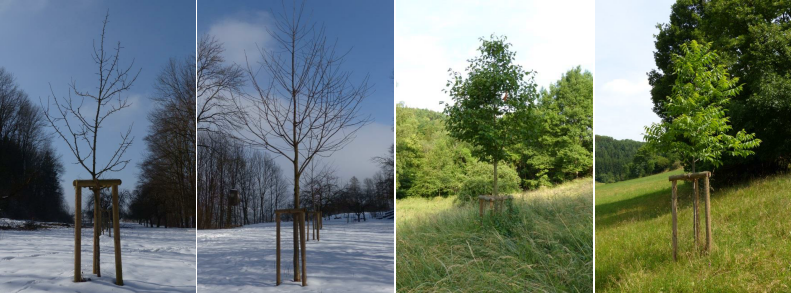By Georg Krause, Donzdorf’s environmental officer and Anja Chalmin
Donzdorf is a city of 11.000 inhabitants in the Stuttgart area of Germany at the fringe of the Schwäbische Alb mountains. The region is located in the transitional zone between urban and rural area and characterized by its traditional fruit orchards.
Between 2007 and 2010 the city established five agroforestry plots with trees for valuable timber production on city-owned land, sized 0,15 to 0,75 ha. The city decided for valuable timber trees, among other reasons because it couldn’t guarantee the maintenance of traditional orchard trees on the selected plots in the long-term.
The following tree species were planted, the bolded tree species are prevailing:
- Wild fruit trees: Prunus avium, Sorbus torminalis, Sorbus domestica, Malus sylvestris
- Traditional, fast-growing fruit varieties: pears (‘Gute Graue’, ‘Palmischbirne’, ‘Gellerts Butterbirne’), plums “Bühler Frühzwetschge’, ‘Ersinger Frühzwetschge’
- Walnuts : Juglans regia, Juglans nigra, Juglans x intermedia
- Black alder (Alnus glutinosa)
The trees were planted on extensive grassland. The land is mown, mulched and/or grassed by sheep.

Georg Krause, Donzdorf’s environmental officer, explained that the agroforestry plots with valuable timber trees are not an alternative to traditional orchards, but a possible additional form of landuse. Due to the use of fast-growing fruit varieties the plots resemble the traditional orchards and fit into the local landscape.
The tree’s ecological value is very important for the city: Georg Krause assumes that not all trees will show perfect growth; the trees concerned will not be replaced but can remain as habitat trees. He also explained that cultural landscapes with orchards were once developed and cultivated by man. Nowadays many orchards are in poor conditions or even disappear, e.g. because the market situation for orchard fruits is depressed. Using fruit trees to produce valuable timber generates an additional value and brings back the concept of use to areas with fruit trees.
In the meanwhile two of the plots have been approved as an eco-account (compensation balance) measure by the responsible local nature conservation authority. One of the areas is a 0,75 ha plot, planted in 2009 and 2010 with traditional orchard varieties, Prunus avium, Sorbus torminalis, Sorbus domestica, Juglans regia and Juglans x intermedia. The land is grassed by sheep. The distance between tree rows is 15m and within the rows 11m. The area integrates five traditional orchard trees.
For the measure the city volunteered to make the following commitments:
- Long-term preservation of remaining traditional orchard trees;
- Permanent extensification of understory (grassland);
- Trees can be cut at the earliest after 60 years, cut trees need to be replaced;
- No clear cuts. Different tree species have varied growth rates, therefore a continuous regeneration of the tree stock is guaranteed;
- 10 % of trees remain untouched as habitat trees;
- Installation of 5 nesting aids.

When asked for practical tips for other communities or farmers, Georg Krause shared the following points: You have to pay sufficient attention to the trees in the establishment phase, mainly for pruning and tree protection measures. In the first years pruning requires sufficient time to examine the trees, e.g. Prunus avium and Sorbus torminalis grow very differently. The initially used wire meshes were repeatingly damaged while mowing or sheep rubbed against them and this led to tilted trees. For this reason Georg Krause is now installing more resistive protection (see above figures). Bent terminal leaders are a problem on one plot without grove structures in the surrounding. The trees are used as raised hides, e.g. by red-backed shrike, yellowhammer and dunnocks. Larger poles attached to the tree protection may be a possible solution in rather featureless landscapes.
Although working intensive in the establishment phase the management of the valuable timber plots can be mastered more easily by the city in the long-term compared to traditional orchards, e.g. longer trunks facilitate the management of the grassland and pruning is less labour intensive. This is one of the reasons why this new approach found broad approval and support within the local community and administration.











